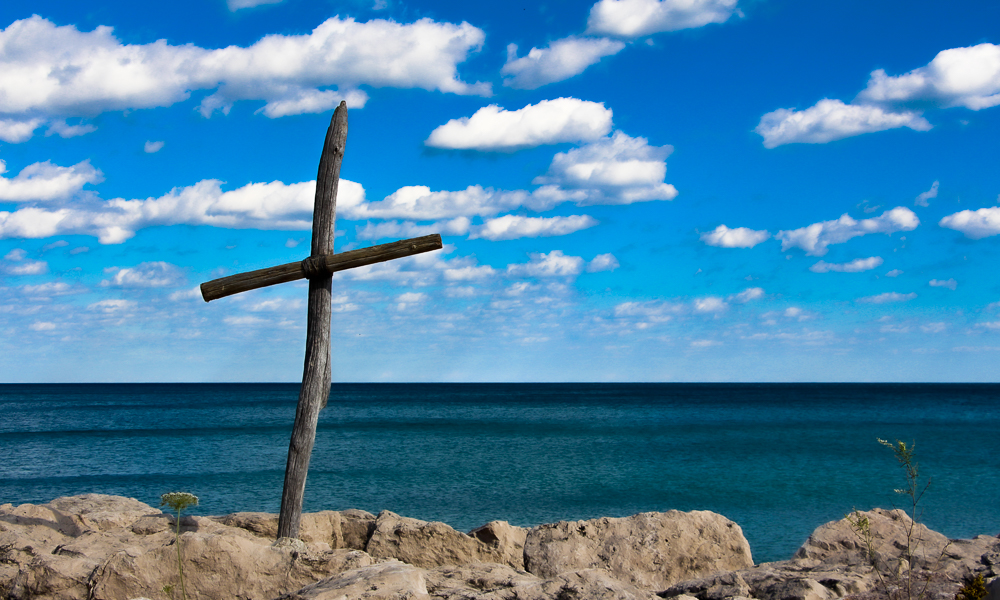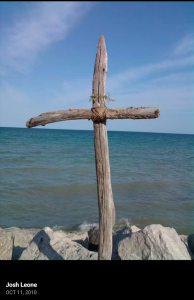
It doesn’t have quite the stature of the “Fishers of Men” statue, but the CUW “Beach Cross” has become an icon on campus. Learn the untold, unfinished story of how it came to be.
Our quest begins with a simple question submitted on one of our social media pages: “Does anyone know the story behind the driftwood cross on CUW beach?”
After asking around a little bit, no answer came immediately. “I always assumed it was probably a Campus Ministry thing,” I said. So I asked Associate Campus Pastor Doug Bender what he knew. As it turns out, Pastor Doug recalled a conversation from a few years ago with a man who may have been the instigator. “I’m still Facebook friends with him,” Doug told me. “Let me see what I can find out.”
Next thing you know, I had a phone interview scheduled with a man named Rick.
Mind, body, and spirit
As Rick tells it, the beach cross has its origins when the beach below the bluff was quite new, not long after the renovation, probably in 2008 [*see update below]. Rick is a retired personal trainer; he’s also in recovery—both facts are relevant to this story. Back then, he would frequently take people he was training up and down the bluff stairs and switchbacks. “It’s the perfect place for training,” he said. “So I started going there quite often.”
One day, he ventured all the way up to where the beach is, on the north end of the shoreline. He found what looked like a bonfire site, with a stack of wood waiting to be burned. Among the sticks of driftwood was what appeared to be a cross, loosely lashed together with a piece of rope.
Maybe some students put it together it and weren’t happy with the results, so they were just going to burn it. Maybe it wasn’t even meant to be a cross. We don’t actually know. But whatever its original intent and purpose, Rick decided it was worth saving. So he pulled it from the pile, tied it up a little tighter, stuck it in the ground, and put some rocks around it to stabilize it.
Satisfied with his work, he went on his way. “Okay, I feel better now,” he thought to himself.
A few weeks later when he came back, the cross was back in the pile. So he saved it again—only this time he “really poked it down in there pretty good!” He made sure it would stay put, and that there would be no doubt he meant for it to stay put. “It would take more than just a couple of guys and girls to yank it out!”
After that he started visiting the cross on a regular basis. He made it part of his morning routine, to go to the cross and pray. Sometimes by himself. Sometimes with friends or clients. Sometimes with his son. It helped him stay close to God.
For years he visited with two friends in particular, Lee and Don. Lee, who Rick credits as his “spiritual advisor,” was a strong Christian. Don is now a senior pastor at a local church. “So Don and Lee and I would go down to the cross and pray. It became very much a part of my life.
“And the reason the cross worked so well for me was, beyond the cross I could see nothing manmade,” Rick explained. “There was nothing interfering with the view. It was just perfect.”
It also helped him stay sober. “I’ve been clean and sober for 28 years now,” he says.
The power of the cross
As Christians, we talk a lot about “the Cross.” It’s a powerful symbol of the faith we hold in common, representing the death that Christ died to pay for all of our sins.
A the front of the CUW Chapel of Christ Triumphant, it is represented with a crucifix; that is, a cross with our Savior still nailed, in the throes of His final hours or minutes—or perhaps already gone from His (pre-resurrection) earthly life. The image of Christ on the cross challenges us to remember the suffering He endured on our behalf.
As Protestants, we more often see the empty cross, which urges us to think about the risen Christ, and what His resurrection means for our salvation. (In our Chapel, this idea is represented by the stained glass depicting “Christ Triumphant” above the main Chapel doors.)
When you think about it, the cross is kind of an odd symbol of hope. Once, early in my faith walk, a spiritual mentor asked me, “Why are you wearing an ancient execution device around your neck?” He was being facetious—sort of. In fact, he was challenging me to remember what the cross around my neck really represented: A Savior who unjustly suffered and died to repay a debt that I never can.
A symbol of death that represents eternal life: Just one of the many seeming paradoxes found in our amazing faith.
In the old rugged Cross, stain’d with blood so divine
“The Old Rugged Cross” | Hymn by George Bennard
A wondrous beauty I see
For ’twas on that old cross Jesus suffered and died
To pardon and sanctify me
Mystery remains
These days, Rick doesn’t get down to visit the cross very often. “My knees are shot,” he says. But he thinks about it often. And people sometimes will text him a picture and say, “Hey, I saw the cross today!” He considers the bluff to be “holy ground,” and his hope is to have his ashes scattered there after he dies.
“Weird, huh?” he says.
Not really. For someone whose physical and spiritual wellbeing have been shaped so much by one special place, it makes sense to want an eternal connection.
“And once you’re out there, and you feel and really understand the power of that cross, you wouldn’t want to turn your back on it,” he adds.
But nothing of this earth lasts forever. Even the beach cross will turn to dust one day. And we still don’t really know the true origin of these lashed pieces of driftwood. Rick doesn’t want credit for anything—it’s why he asked his last name not be used. And he knows he didn’t really create anything. He just helped preserve it. “Somebody else found those two pieces of driftwood and lashed them together,” he says.
We just don’t know who that was. Do YOU? If you have any information regarding the true origin of the beach cross, let us know. (You can email me at michael.zimmerman@cuw.edu.) There’s no reward for information, other than the heavenly reward awaiting those who put their faith in Jesus Christ and the cleansing power of the blood He shed on the cross.
“For the word of the cross is folly to those who are perishing, but to us who are being saved it is the power of God.” – 1 Corinthians 1:18

UPDATE:
Shortly after the publication of this article, I heard from Tyler Shadick (‘12), learning management system administrator for the CUW IT Department. Tyler reports that it was a friend of his, Josh Leone, who originally built the cross in October 2010. In a phone call, Josh explained that he was visiting Tyler, who was a student at the time, when he saw the logs on the beach and thought they would make a cool cross. So he bought some rope, lashed the logs together, and planted the cross in the ground. Thanks, Tyler and Josh, for sharing this additional information!
Want in?
Concordia University Wisconsin is part of the Concordia University System, a nationwide network of colleges and universities that are each independently run but all affiliated with The Lutheran Church-Missouri Synod. Our university educates students across a broad range of professional fields, and also offers professional church career education in the areas of Pre-Seminary studies, Lutheran teacher training, parish music, and church ministries leadership.